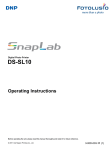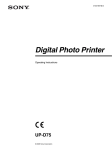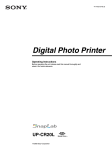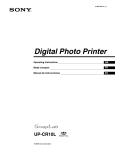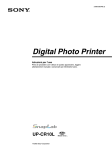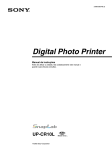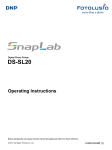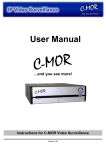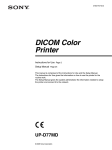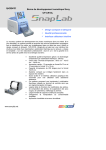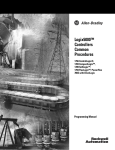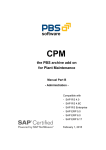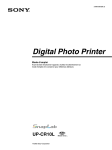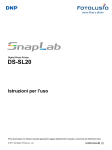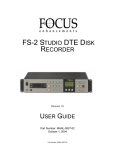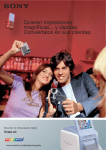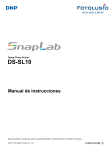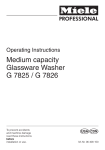Download Digital Photo Printer
Transcript
2-666-583-16 (1) Digital Photo Printer Operating Instructions Before operating the unit, please read this manual thoroughly and retain it for future reference. UP-CR10L © 2005 Sony Corporation English Owner’s Record The model and serial numbers are located at the rear. Record these number in the space provided below. Refer to these numbers whenever you call upon your Sony dealer regarding this product. Model No. ____________________ Serial No. ____________________ WARNING To reduce the risk of fire or electric shock, do not expose this apparatus to rain or moisture. To avoid electrical shock, do not open the cabinet. Refer servicing to qualified personnel only. THIS APPARATUS MUST BE EARTHED. Note The location and design of the unit’s power control and the supplied accessories differ depending on the serial number found on the manufacturer label located at the rear of the unit. These differences are described in this document whenever they arise. For units with serial numbers starting with 51 only To disconnect the main power, unplug the AC IN connector. For units with serial numbers starting with 11 only This unit has no power switch. When installing the unit, incorporate a readily accessible disconnect device in the fixed wiring, or connect the power plug to an easily accessible socket-outlet near the unit. If a fault should occur during operation of the unit, operate the disconnect device to switch the power supply off, or disconnect the power plug. For the customers in the U.S.A. This equipment has been tested and found to comply with the limits for a Class B digital device, pursuant to Part 15 of the FCC Rules. These limits are designed to provide reasonable protection against harmful interference in a residential installation. This equipment generates, uses, and can radiate radio frequency energy and, if not installed and used in accordance with the instructions, may cause harmful interference to radio communications. However, there is no guarantee that interference will not occur in a particular installation. If this equipment does cause harmful interference to radio or television reception, which can be determined by turning the equipment off and 2 on, the user is encouraged to try to correct the interference by one or more of the following measures: • Reorient or relocate the receiving antenna. • Increase the separation between the equipment and receiver. • Connect the equipment into an outlet on a circuit different from that to which the receiver is connected. • Consult the dealer or an experienced radio/TV technician for help. You are cautioned that any changes or modifications not expressly approved in this manual could void your authority to operate this equipment. All interface cables used to connect peripherals must be shielded in order to comply with the limits for a digital device pursuant to Subpart B of Part 15 of FCC Rules. If you have any questions about this product, you may call; Sony Customer Information Service Center 1-800-2227669 or http://www.sony.com/ Declaration of Conformity Trade Name : SONY Model : UP-CR10L Responsible Party : Sony Electronics Inc. Address : 16530 Via Esprillo, San Diego, CA 92127 U.S.A. Telephone Number: 858-942-2230 This device complies with part 15 of the FCC Rules. Operation is subject to the following two conditions: (1) this device may not cause harmful interference, and (2) this device must accept any interference received, including interference that may cause undesired operation. For the customers in Canada This Class B digital apparatus complies with Canadian ICES-003. Warning on power connection Use a proper power cord for your local power supply. 1. Use the approved Power Cord (3-core mains lead)/ Appliance Connector/Plug with earthing-contacts that conforms to the safety regulations of each country if applicable. 2. Use the Power Cord (3-core mains lead)/Appliance Connector/Plug conforming to the proper ratings (Voltage, Ampere). If you have questions on the use of the above Power Cord/ Appliance Connector/Plug, please consult a qualified service personnel. For the customers in Europe The manufacturer of this product is Sony Corporation, 17-1 Konan, Minato-ku, Tokyo, Japan. The Authorized Representative for EMC and product safety is Sony Deutschland GmbH, Hedelfinger Strasse 61, 70327 Stuttgart, Germany. For any service or guarantee matters, please refer to the addresses given in separate service or guarantee documents. For kundene i Norge Dette utstyret kan kobles til et IT-strømfordelingssystem. For the customers in the U.S.A. Lamp in this product contains mercury. Disposal of these materials may be regulated due to environmental considerations. For disposal or recycling information, please contact your local authorities or the Electronic Industries Alliance (www.eiae.org). 3 Table of Contents Chapter 1 Outline What This Product Can Do ............................................................. 6 Supplied Documentation ................................................................ 7 Information Updates........................................................................ 7 Chapter 2 Preparations Supplied Accessories ..................................................................... 8 Controls and Functions .................................................................. 9 Front ...................................................................................................... 9 Rear ..................................................................................................... 10 Installation...................................................................................... 11 Connecting the Power Cord ................................................................ 11 Adjusting the Display Angle ............................................................... 11 Loading Paper Roll and Ribbon Cartridge .......................................... 12 Attaching the Paper Tray..................................................................... 18 Preparing an Expansion CompactFlash Card...................................... 19 Startup and Shutdown .................................................................. 20 Startup ................................................................................................. 20 Shutdown............................................................................................. 21 Checking the Ribbon Cartridge Remainder ........................................ 21 Chapter 3 Setup Setup Procedure ............................................................................ 22 Setting Items .................................................................................. 23 System Tab .......................................................................................... 23 Screens Tab ......................................................................................... 24 Template Tab....................................................................................... 25 Text Input Screen ................................................................................ 25 Print Tab .............................................................................................. 26 Print Color Tab.................................................................................... 26 Pricing Tab .......................................................................................... 27 Administration Tab.............................................................................. 28 4 Table of Contents Chapter 4 Operation Operation Outline .......................................................................... 30 Print Types .......................................................................................... 30 Operation Flow.................................................................................... 31 Setting Memory Cards................................................................... 32 Using a “Memory Stick” ..................................................................... 32 Using a CompactFlash Card................................................................ 32 Using a SmartMedia Card ................................................................... 33 Using a SD Card/MultiMediaCard...................................................... 33 Using a xD-Picture Card ..................................................................... 34 Using Bluetooth communication......................................................... 34 Selecting Images for Printing ....................................................... 34 Verifying Order Contents and Entering a Password ........................... 37 Using Index Print ........................................................................... 38 Using Split Image Print ................................................................. 39 Using Border Print......................................................................... 41 Printing All Images on a Memory Card........................................ 44 Image Editing ................................................................................. 45 Specifying the Layout (Crop & Rotate) .............................................. 46 Adjusting the Image Quality ............................................................... 47 Printing in Sepia or Black and White.................................................. 47 Compensating for the Red Eye Effect ................................................. 48 Adding the Date ............................................................................. 49 Printing From DPOF Settings ....................................................... 49 Printing With Bluetooth® Communication.................................. 50 Preparing for Bluetooth communication ............................................. 50 Printing from Bluetooth-compatible devices ...................................... 50 Entering Passwords Using Memory Cards (Remote Password Input)....................................................... 52 Creating password files ....................................................................... 52 Entering passwords using memory cards ............................................ 52 Printing From a Computer ............................................................ 53 Installing the Printer Driver................................................................. 53 Connection to a Computer................................................................... 53 Appendix Precautions .................................................................................... 54 Supported Memory Cards and File Formats ............................... 55 Notes on Using Memory Cards ........................................................... 55 Cleaning.......................................................................................... 58 Cleaning the Inside of the Printer........................................................ 58 Troubleshooting ............................................................................ 61 Ribbon Cartridge and Paper ......................................................... 61 Specifications ................................................................................ 62 Table of Contents 5 Chapter 1 Outline Outline What This Product Can Do This device reads image data from memory cards used by devices such as digital cameras and prints out photos of superb quality. It also prints out data sent from a computer. The product has the following features. 1 Customizable with original data By inserting a memory card (expansion CompactFlash card) carrying promotional images and border data into the expansion slot, screen savers can be displayed and photos can be combined with borders for printing.1) Original images can be used for the screen saver and border data. Printing with Bluetooth® wireless technology Besides regular photo printout, the unit can produce split image prints, prints with borders, and index prints. It also allows the user to edit images before printing with functions such as trimming and color adjustment. Order numbers can be printed as a watermark, making print sorting easy. Using an optional Bluetooth USB adaptor 2), you can send images from Bluetooth-compatible devices such as mobile phones and print wirelessly. The versatile print services available when printing from a memory card are also available when sending images via Bluetooth communication. An expansion CompactFlash card is necessary to use this function. Selectable operation modes Compact, integrated body To fit the environment where the unit is used, Full mode, Quick Print mode, and Event mode can be selected. The display and printer are housed in a single enclosure which does not take up much space and easily fits on a shop counter or similar. In addition, the screen angle can be adjusted to eight different settings to fit operation conditions. Versatile print services Support for a wide range of memory cards All major memory card formats used in digital cameras are supported: “Memory Stick”, xD-Picture Card, SD Card, MultiMediaCard, CompactFlash card, Microdrive, and SmartMedia card. High-speed high-quality printing Using a newly developed print engine that features a dyesublimation thermal transfer technology, it is possible to print images of lasting beauty at high speed. Easy operation by touch panel An 8-inch touch panel display is used, allowing for easy operation with just a touch of the screen. Also, by incorporating a paper roll and ribbon cartridge system, replacement of the paper and ribbon is a snap. 6 Chapter What This Product Can Do 1) A commercially available CompactFlash card or Microdrive is required. 2) For more on compatible Bluetooth USB adaptors, see “Optional accessories” on page 62 of “Specifications.” The adaptor may not be commercially available depending on your country or region. Consult your local Sony dealer. Supplied Documentation The product comes with the following documentation. The Instruction Manual is aimed at owners of the product and contains detailed information about the following topics: • Installation • Setup • Printing image data stored on memory cards • Troubleshooting Basic Operation Guide (PDF) The Basic Operation Guide file contains simple instructions and information about the topics listed below. You should print out parts of this file as necessary and post them near the product for user guidance. • How to print photos in Full mode (aimed at customers) • How to print photos in Quick Print mode (aimed at customers) • Maintenance (aimed at shop personnel) Chapter 1 Outline Instruction Manual (this document) • SmartMedia is a registered trademark of Toshiba Corporation. • MultiMediaCard is a trademark of Infineon Technologies AG. • Microdrive is a registered trademark of Hitachi Global Storage Technologies. • miniSD is a trademark of SD Card Association. • Adobe and Photoshop are either registered trademarks or trademarks of Adobe Systems Incorporated in the United States and/or other countries. • xD-Picture Card is a trademark of Fuji Photo Film Co., Ltd. • The Bluetooth® word mark and logos are owned by the Bluetooth SIG, Inc. and any use of such marks by Sony Corporation is under license. • Other product names are the registered trademarks or trademarks of their respective manufacturers. Information Updates For the latest information, please visit the UP-CR10L support page at http://www.sony.net/snaplab. Printer Driver Installation Guide (PDF) The Printer Driver Installation Guide explains how to install and use the printer driver for the unit on a computer. Adobe Photoshop Plug-in Module User’s Guide (PDF) The Adobe Photoshop Plug-in Module User’s Guide explains how to install the Photoshop plug-in and how to use Photoshop to create templates for prints with borders. Connection Manual to Job Ticket Printer (PDF) The Connection Manual to Job Ticket Printer explains the steps involved in connecting the UP-CR10L to a commercially available thermal receipt printer and printing job tickets. Trademarks The following words are trademarks of their respective owners. • “Memory Stick”, “MagicGate Memory Stick”, “Memory Stick Duo”, “Memory Stick PRO”, and “Memory Stick PRO Duo” are trademarks of Sony Corporation. • CompactFlash is a trademark of SanDisk Corporation, registered in the United States and other countries. Supplied Documentation / Information Updates 7 Preparations Chapter Chapter 2 Preparations Note The location and design of the unit’s power control and the supplied accessories differ depending on the serial number 2 found on the manufacturer label located at the rear of the unit. These differences are described in this document whenever they arise. Supplied Accessories Make certain you have received the following accessories: Paper Tray (1) Paper Holder 1) Cleaning Cartridge (1) 2) Power Cord (1) These accessories are stored in the paper holder. Paper Core (1) USB Cable (with Ferrite Core) (1) 3) Ferrite Core (1) 4) CD-ROM (1) 1) 2) 3) 4) Adaptor (right,1) Before Using this Printer (1) Software License Agreement (1) Warranty Card (1) The paper holder is stored in the printer. Be sure to remove the paper holder from the inside of the printer before turning the power on. For information on use, see the section “Cleaning the Inside of the Printer” on page 58. For units with serial numbers starting with 11 only. For units with serial numbers starting with 51 only. Notes • When taking the unit out of the carton box, be careful not to hurt your back. • The packaging materials are needed when transporting the unit, so we suggest you keep them. 8 Adaptor (left,1) Supplied Accessories • Before transporting the unit, remove the ribbon cartridge and paper roll from the unit. • Before transporting the unit, also remove any paper remnants from the paper holder. The paper remnants may slip into the inner parts of the unit and result in damage if not removed. Controls and Functions Front 1 23 4 5 Chapter 2 Preparations 6 8 9 0 qa a Display Shows the operation screen. Because the display is a touch screen, the user simply touches the field for the desired operation. The angle of the display can be adjusted for best viewing. 7 qs Note To avoid loss of image data or damage to the main unit, never attempt to insert a “Memory Stick”, SmartMedia card, SD Card, or MultiMediaCard into a CompactFlach type adapter set in the CompactFlach slot. b Access indicator Lights when a memory card is inserted a slot, and flashes when a memory card is being accessed. h Eject slot The printed photo emerges from this slot. c “Memory Stick” slot (page 32) Holds a “Memory Stick” with stored image data. i Paper tray (page 18) Printed photos are collected in this tray. d xD-Picture Card slot (page 34) Holds an xD-Picutre Card with stored image data. j Paper eject stopper (page 18) When using the print pack 2UPC-C13, this stopper should be raised. e SD Card/MultiMediaCard slot (page 33) Holds an SD Card or MultiMediaCard with stored image data. k Front door (page 12) Open this door to change the paper roll. f SmartMedia card slot (page 33) Holds a SmartMedia card with stored image data. g CompactFlash card slot (page 32) Holds a CompactFlash card with stored image data. Controls and Functions 9 Front door open Rear For units with serial numbers starting with 11 4 5 6 1 Chapter 2 Preparations 2 7 3 A B A Paper holder (page 12) The paper roll is inserted here. The white areas between printouts are cut off and collected in the top portion of the paper holder. The seven-digit serial number is located here. For units with serial numbers starting with 51 B Paper holder release button (page 12) Press this button to remove the paper holder. 4 l Side door (page 15) Open this door for replacing the ribbon cartridge and inserting the expansion CompactFlash card. Side door open A B 1 6 8 2 7 3 A Ribbon cartridge access opening (page 15) Mount the ribbon cartridge here. B Expansion CompactFlash card slot (page 19) When using border print, promotional images display, text input, or print spool, insert the expansion CompactFlash card here. 10 Controls and Functions a USB port (host) Allows connection of a USB device. You can connect a commercially available card reader or USB flash memory device to this port and use it to read data.1) To use Bluetooth communication, insert a Bluetooth USB adaptor here. 1) Correct operation with every card reader and USB flash memory device is not guaranteed. Operation is not guaranteed when connected by a USB hub. PictBridge is not supported. b USB port (device) (page 53) Use a USB cable to connect the unit to a computer.1) 1) Operation is not guaranteed when connected by a USB hub. c ~ AC IN (Power Source) Connector (page 11) Connect the supplied power cord here. Installation d Display stand Use this stand to adjust the angle of the display. Connecting the Power Cord Connect the supplied power cord to the ~ AC IN connector on the back of the unit, and then connect the plug to a power outlet. Chapter 2 Preparations e On/Standby button (for units with serial numbers starting with 11 only) Press this button to turn on power to the unit. Press it again to enter the standby mode. To restart the unit from standby mode, wait at least 5 seconds in standby mode, and then press the On/Standby button. f RS-232C interface Serves for future expansion. Currently not used. g Air vent Features a built-in filter for the thermal head cooling fan. h POWER switch (for units with serial numbers starting with 51 only) Turns the unit on or off. Power cord (supplied) Power outlet Adjusting the Display Angle The display angle can be adjusted to make the display more easily viewable. Eight settings are available for angle adjustment. When storing the unit, pull the display forward until completely upright and then push it backward until horizontal. Installation 11 Loading Paper Roll and Ribbon Cartridge • An IC board is incorporated in the ribbon cartridge. Do not touch the terminal of the IC board with anything, including your fingers or metallic objects. Also, do not strike, bend, or drop the IC board. Handling the paper roll and ribbon cartridge Notes Chapter 2 Preparations • The print pack contains two ribbon cartridges and two paper rolls. Be sure to use the ribbon cartridge and paper roll in the same carton as a set. (See “Ribbon Cartridge and Paper” on page 61.) • The number of sheets that can be printed depends on the print pack type. The table below lists the image count for one ribbon cartridge and paper roll set. Print pack 2UPC-C13 2UPC-C14 2UPC-C15 Number of 300 (sheets) sheets 200 (sheets) 172 (sheets) Print size 101 × 152 mm ±2 mm (4 × 6 inches ±3/32 inch) 126 × 178 mm ±2 mm (5 × 7 inches ±3/32 inch) 89 × 126 mm ±2 mm (3.5 × 5 inches ±3/32 inch) IC board Attaching adaptors to paper holder Paper roll widths vary according to the print pack. When using the 2UPC-C14 print pack, attach an adaptor to the paper holder to compensate for the width difference. 1 Open the front door. 2 Press the paper holder release button and pull the paper holder out. • Do not replace the ribbon cartridge and paper roll before they are used up. Otherwise the above number of sheets may not be achieved. • Place the paper roll vertically. If you place the paper roll horizontally, the paper roll may roll around and fall. This may cause an injury. • Hold the paper roll with both hands so that you do not drop it, because it is heavy. Dropping may result in an injury. Hold the paper roll with both hands. 12 Installation Press the latch on top of the paper holder and open the holder. 4 Adjust the width of the paper holder. When using the print pack 2UPC-C13 or 2UPC-C15 Remove the adaptors from the paper holder. Chapter 2 Preparations 3 When using the print pack 2UPC-C14 Attach adaptors to both ends of the paper holder. Note Store the adaptors in a safe place so as not to lose them. Loading the paper roll and ribbon cartridge When using the printer for the first time, you must first load a paper roll and ribbon cartridge. When using the 2UPC-C14, adaptors must be installed in the paper holder, as described in the section “Attaching adaptors to paper holder” on page 12. For information on how to remove a spent paper roll and ribbon cartridge, see the section “Removing the paper roll and ribbon cartridge” on page 16. Memo Make sure the color of the label on the upper part of the adaptors matches the color of the label on the paper holder. Notes • Always use a designated print pack. • Always replace the paper roll and ribbon cartridge together as a set. Loading the paper roll Note Insert the adaptors firmly and completely into the paper holder. 1 Insert the paper core into the paper roll. Installation 13 Notes 4 Press the latch on top of the paper holder and open the holder. 5 Insert the paper roll into the paper holder. • If the edges of the paper roll are uneven, make sure to even them out before installing the paper roll. Otherwise a malfunction may occur. Chapter 2 Preparations • If the paper is wound loosely around the core, make sure to wind it tightly before installing the paper roll. Otherwise a malfunction may occur. • Do not grasp the paper too tightly or strike it against a hard object, because the paper may tear or crease, effecting the print quality. 2 The arrow on the label in the center of the paper roll must point inwards. Open the front door. Note When installing the paper roll, make sure the paper holder is completely open. Otherwise a malfunction may occur. 3 Press the paper holder release button and pull the paper holder out. 6 Remove the label in the center of the paper roll. Notes • Make sure to fully remove all labels from the paper roll. If labels remain inside the printer, operation problems may occur. • After inserting the paper roll, do not touch the printing surface (the inner surface of the rolled paper). Fingerprints, sweat, creases etc. can lead to reduced print quality. • Insert the paper roll firmly and completely into the paper holder. 14 Installation 7 Close the paper holder. 9 Close the front door. Chapter 2 Preparations Note When closing the paper holder, take care that the leading edge of the paper roll does not stick out of the paper feed opening. 8 Loading the ribbon cartridge 1 Open the side door. 2 Insert the ribbon cartridge completely. Return the paper holder into the unit. Insert the paper holder until you hear a sharp click. Installation 15 Notes • If it is difficult to insert the ribbon cartridge, remove it and try inserting it again. Reduce the ribbon slack by turning the cartridge spool in the direction of the arrow only if the ribbon cartridge cannot be inserted due to slack in the ribbon. Chapter 2 Preparations • Do not rewind the ribbon cartridge for reuse in printing. Printing will not be performed properly, and it may cause a malfunction to occur. • Do not try to replace the ribbon cartridge while printing is in progress. • Immediately after printing, the thermal head inside the unit will be hot. When loading a cartridge, do not insert your hand into the ribbon cartridge access opening, to prevent the risk of burns. 3 • There is extra paper on the paper roll. When the ribbon cartridge is finished, remove the remainder of the paper roll and install a new ribbon cartridge and paper roll. • Make sure to use a matching paper roll and ribbon cartridge set. Using an unmatched combination will not only prevent you from obtaining normal print results but may cause a paper jam or a malfunction. • Do not touch the printing surface of the paper roll or the ink on the ribbon cartridge. Fingerprints and other pollutants can lead to reduced print quality. Removing the paper roll and ribbon cartridge Removing the paper roll 1 Open the front door. 2 Press the paper holder release button and pull the paper holder out. Close the side door. Notes on storage • Avoid placing where subject to: – high temperatures – high humidity or dust – direct sunlight • After opening the bag, use the ribbon cartridge and the paper as soon as possible. • When storing after partial use, put the ribbon and the paper back in their bags. 16 Notes Installation Remove any paper remnants from the paper holder. Removing the ribbon cartridge 4 Press the latch on top of the paper holder and open the holder. 1 Open the side door. 5 Remove the paper roll. 2 Pull back the latch on the ribbon cartridge to release the lock, and then grasp the ribbon cartridge and remove it. 6 Chapter 2 Preparations 3 Pull out the paper core from the paper roll. Memo If the ink ribbon breaks, you can reconnect it with a piece of tape and use the remaining ribbon. Note Immediately after printing, the thermal head inside the unit will be hot. When removing a cartridge, do not insert your hand into the ribbon cartridge access opening, to prevent the risk of burns. Note You will need to reuse the paper core. Be careful not to misplace it. Installation 17 3 Close the side door. Chapter 2 Preparations Attaching the Paper Tray Attach the supplied paper tray. When using the print pack 2UPC-C14 or 2UPCC15 About 100 sheets of printouts can be left on this paper tray. However, the number of printouts which can be accumulated on the paper tray changes according to the environment condition where the printer is used or the printed image. Remove the printed sheets accumulated on the paper tray as soon as possible. When using the printing pack 2UPC-C13 Raise the eject paper stopper. About 100 sheets of printouts can be left on this paper tray. However, the number of printouts which can be accumulated on the paper tray changes according to the environment condition where the printer is used or the printed image. Remove the printed sheets accumulated on the paper tray as soon as possible. Note Do not touch the printouts until they have been ejected from the printer. If a printout gets stuck in the eject slot, remove it from the slot immediately. To remove the paper tray Grasp the bottom of the paper tray, lift it up while keeping it horizontal, and pull it out. 18 Installation Preparing an Expansion CompactFlash Card Inserting the expansion CompactFlash card 1 Open the side door. 2 Insert the expansion CompactFlash card that you have created into the expansion CompactFlash card slot. 3 Close the side door. Creating the expansion CompactFlash card The supplied CD-ROM contains sample templates for border prints and sample promotional images. You can create an expansion CompactFlash card by copying this data onto a CompactFlash card with your computer. If your computer cannot use CompactFlash cards, you can copy the data to another type of memory card temporarily and then copy it to a CompactFlash card with the unit. 1 Insert the CompactFlash card into the computer. 2 Copy the promotional images. Chapter 2 Preparations For using the following functions, an expansion CompactFlash card is required: • Border print • Promotional images display • Text input • System logs and print logs export • Printing with Bluetooth communication To create the expansion CompactFlash card, a commercially available CompactFlash card is used. The CompactFlash card can be a Type I, Type II, or Microdrive. We recommend using a CompactFlash card with at least 512 MB of free space. Create the folder “\Sony\UPCR\” in the root folder of the CompactFlash card, and copy the entire folder “\Sony\UPCR\Promotion” into it from the supplied CD-ROM. 3 Copy the border print templates. The templates are stored in the folder “\Sony\UPCR\Template” on the supplied CD-ROM. The folder is divided into subfolders for each print size (3×5, 4×6, and 5×7). Create the folder “\Sony\UPCR\Template” in the root folder of the CompactFlash card, and copy the entire folder for each desired print size into it. A CompactFlash card with at least 512 MB of free space is required to copy all the data stored on the CDROM. If you have copied the CD-ROM data to a memory card other than a CompactFlash card, you will need to use the unit to copy it from that memory card to a CompactFlash card. For details on copying the data, see “Template Tab” on page 25. Installation 19 The unit starts up, and the following screen appears. Startup and Shutdown Startup Start the unit as follows. For units with serial numbers starting with 11 Chapter 2 Preparations Verify that no memory card is inserted in any of the frontside memory card slots of the unit. Then press the on/ standby button. For details on subsequent steps, see the section “Operation” on page 30. For units with serial numbers starting with 51 Verify that no memory card is inserted in any of the frontside memory card slots of the unit. Then turn on the POWER switch. 20 Startup and Shutdown Shutdown 1 Complete any pending operations, and then bring up the following screen. Checking the Ribbon Cartridge Remainder You can check the remainder of the ribbon cartridge. 1 At the Start Guide display, touch the top right corner of the screen twice in succession. Chapter 2 Preparations 2 Shut down the unit as follows. For units with serial numbers starting with 11 Verify that no memory card is inserted in any of the front-side memory card slots of the unit. Then press the on/standby button. The remainder of the ribbon cartridge is displayed. For units with serial numbers starting with 51 Verify that no memory card is inserted in any of the front-side memory card slots of the unit. Then turn off the POWER switch. The original screen reappears after 5 seconds. Startup and Shutdown 21 Setup Chapter 3 Chapter 3 Setup Setup Procedure 3 Touch the [OK] button. The administration screen appears. Before the unit can be used, you must first make various settings. This includes selecting the language and currency, selecting the service mode, and setting up passwords. These settings are made from the administration screen. You can also use the administration screen later to change settings and to adjust the unit. To bring up the administration screen, proceed as follows. Notes • Before you can make settings on the administration screen, you must enter the administrator password. In the factory default condition, the administrator password is set to “9999”. • If a memory card is inserted in any of the front-side memory card slots of the unit, the administration screen does not come up. Remove any memory cards first, and then repeat the procedure. 1 At the Start Guide display, touch the top left corner of the screen twice in succession. The password entry screen appears. 2 22 Enter the password using the numeric keypad. Setup Procedure By touching one of the tabs at the top of this screen, you can select the respective category to make settings. For details on each category, see the section “Setting Items” on page 23. (System) tab Lets you select the language to be used by the system, the beep ON/OFF setting, and the computer connection function. The touch panel adjustment can also be performed from this tab. (Screens) tab Lets you select the operation mode and the promotional images function. (Template) tab Lets you load and delete templates and enter text to be added to images. (Print) tab Lets you select the order numbering format and the date format. The print position adjustment can also be performed from this tab. (Print color) tab Lets you adjust the print quality. (Pricing) tab Lets you set the currency to use and the price of prints. (Administration) tab Lets you limit the number of prints per order and make password settings. The print logs and system logs can also by displayed from this tab. 4 Setting Items System Tab When the setting is complete, touch the button. Chapter 3 Setup Beep Determines whether a beep sound is heard when performing an operation step or when an error has occurred. PC Connection Determines whether the unit can be controlled from a computer. When set to [OFF], the unit cannot be controlled from a computer even if connected via a USB cable. Language Selects the language to be used for operation screens and messages. Up to four languages can be selected. When multiple languages are selected, the user can select the language when placing an order. The administration screen uses the language selected as [1]. 1 Touch one of the buttons [1] - [4]. A list of languages appears. 2 Touch the language you want to use and touch the [OK] button. To cancel a setting, touch [(Off)]. Note When only one language was selected, the language selection screen does not appear when placing an order. Setting Items 23 Touch Panel Adjustment Chapter 3 Setup This allows you to calibrate the touch panel. Touch the button, and then touch the box that appears on the screen. When you touch the box, a new box appears in a different location. Touch each of the boxes in order. When no more boxes appear, the touch panel adjustment is complete. • Event Mode This mode is designed for providing free access to printing functions, for example at a party, wedding reception, or similar. The mode is also suitable for use by shop employees rather than customers. No password entry or price confirmation are required before starting to print. Print Head Cleaning Promotional Images This allows you to clean the inside of the printer. For details, see the section “Cleaning the Inside of the Printer” on page 58. Allows you to set the promotional images. Up to two images can be specified for display during standby in Full mode or Quick Print mode. In the default condition, the Start Guide is used as standby screen. When one or two images have been specified, these are shown alternately with the Start Guide. To use the promotional image function, an expansion CompactFlash card is required. For information on the expansion CompactFlash card, see the section “Preparing an Expansion CompactFlash Card” on page 19. You may create your own promotional image using commercially available photo editing software. Screens Tab Promotional image specifications • Image size: 640 (W) × 480 (H) pixels • File format: 24-bit Windows BMP • File name: Image 1 = promo1.bmp, Image 2 = promo2.bmp • File storage location: \Sony\UPCR\Promotion • Mode Selection You can select either Quick Print mode, Full mode, or Event mode. • Quick Print This mode limits the number of options that are available to the customer. It is best suited to allow easy and quick printing of photos. The customer can select whether to print only selected images from the memory card or all images on the memory card. Image editing is not possible. You can require the input of a password before printing is carried out. • Full Mode In this mode, the customer can access the full range of functions provided by the unit. In addition to normal printing, this includes Split Image print, Index Print, and Border Print. Image editing is also possible. You can require the input of a password before printing is carried out. 24 Setting Items (Import promotional image) This button lets you import a promotional image from memory card inserted front-side memory card slot. If an error message appears, check the following likely causes. – The expansion CompactFlash card has insufficient free space. – The file selected for copying is not in the specified folder or does not meet the promotional image specifications. Note If there are promotional images already stored on the expansion CompactFlash card, they will be overwritten. Be careful when performing this procedure, because even read-only files will be forcibly overwritten. • Image 1, Image 2 Selects the time period for which the promotional image is displayed. When the time has elapsed, the unit automatically switches to the next image. When [OFF] is selected, the promotional image is not shown. It is not possible to set Image 1, Image 2, and Start Guide all to [OFF] at the same time. Start Guide Selects the time period for which the Start Guide is displayed. When the time has elapsed, the unit automatically switches to the promotional image. When [OFF] is selected, the Start Guide is not shown. It is not possible to set Image 1, Image 2, and Start Guide all to [OFF] at the same time. Template Tab • (Delete All) Deletes all template data stored on the expansion CompactFlash card. Note Be careful when performing this procedure, because even if the existing templates are read-only files, they will be forcibly deleted. Text Input Chapter 3 Setup You can enter text for addition to images. When [Print] or [Border Print] is performed, the entered text is printed along with the image. Alphanumeric characters and symbols can be used to create text. To enter text, touch the [Text Setting] button to bring up the text input screen. For information on how to use this screen, see the section “Text Input Screen” below. To use the entered text, select [ON]. Text Input Screen This lets you load and delete templates for border print and enter text to be generated. To use the Template tab, an expansion CompactFlash card is required. For information on the expansion CompactFlash card, see the section “Preparing an Expansion CompactFlash Card” on page 19. Templates are created using the Adobe Photoshop plug-in that is contained on the supplied CD-ROM. For details, see the documentation of the Adobe Photoshop plug-in. Templates • (Copy All) Copies all template data stored on a memory card inserted front-side memory card slot to the expansion CompactFlash card. Touch the button and then follow the instructions that appear. If an error message appears, check the following likely causes. – The expansion CompactFlash card has insufficient free space. – The file selected for copying is not in the specified folder or does not meet the promotional image specifications. Note If there are templates with the same name stored on the expansion CompactFlash card, they will be overwritten. Be careful when performing this procedure, because even read-only files will be forcibly overwritten. [Input] tab Touch the keys shown on the screen to enter text. Up to 2 lines containing a total of 128 alphanumeric characters can be entered. To make a correction, touch the [BS] (Backspace) button. If you keep touching the button, the entire line where the cursor is located will be erased. [Font] tab Lets you select the font to be used. [Size] tab Use the [+] and [-] buttons to control the text size. The size setting range is 8 - 72 points, in 2-point steps. Setting Items 25 [Position] tab Print position adjustment Lets you specify where in the image the text should be placed. If the print is not properly centered on the paper, you can adjust the position in the X and Y direction. The adjustment range is ±2 mm in each direction. [Color] tab Lets you specify the text color. Note Decrease the Y value Depending on the number of characters and text size selected, it may not be possible to print the entire text in some cases. Chapter 3 Setup Increase the X value Print Tab Decrease the X value Increase the Y value Y: The direction the prints are ejected. Print Color Tab Order Numbering Select one of the following settings related to including the order number on the prints. • OFF No order number is printed. • (Print all) The order number is printed on all photos. • (Print first only) The order number is printed on the first image of each order. If you print multiple copies of the first image, the order number is printed on each copy. The order number is printed as a watermark on the edge of the photo. Various settings related to print color and quality can be made here. Each item is set with the [b] and [B] buttons. The setting range is ±16 in steps of 2. Date Print Format Red, Green, Blue Specifies the format that is used when including the date in the printout. Adjusts the color component of the respective color. • • • • Dark, Light YYYYMMDD (Example: 2005/10/30) DDMMYYYY (Example: 30/10/2005) MonthDDYY (Example: Oct/30/05) MMDDYYYY (Example: 10/30/2005) Adjusts gradation in dark and light sections. Gamma Adjusts the halftone density. 26 Setting Items Sharpness Adjusts the outline sharpness of the image. Pricing Tab Specifies whether the price is shown on the image selection and preview screens. Currency Selects the currency to use when calculating the price for an order. When you touch the button, a list of currencies such as indicated below appears. Touch the currency to use, and touch the [OK] button. When not displaying the currency, select [(12.34)] (to display decimal points) or [(1234)] (not to display decimal points). On-screen abbreviation Currency AUD Australian Dollar CAD Canadian Dollar CHF Swiss Franc DKK Danish Kroner EUR Euro GBP British Pound GRD Greek Drachma ILS Israeli Shekel YEN Japanese Yen NOK Norwegian Kroner NT Taiwan New Dollar NZD New Zealand Dollar PHP Philippine Peso RMB Chinese Yuan Rs Indian Rupee Currency RUB Russian Ruble SEK Swedish Krona SGD Singapore Dollar THB Thai Baht TRL Turkish Lira USD US Dollar HKD Hong Kong Dollar KRW South Korean Won MXN Mexican Peso BRL Brazilian Real COP Colombian Peso VEB Venezuelan Bolivar XCD East Carribbean Dollar ARS Argentinian Peso CLP Chilean Peso PEN Peruvian Nuevo Sol PAB Panama Balboa ECS Ecuador Sucre JMD Jamaican Dollar UYU Uruguayan Peso Chapter 3 Setup Price Indication On-screen abbreviation Pricing • 3×5", 4×6", 5×7" Lets you set the price per print for each size. Touch the button. Using the numeric keypad that appears, enter the value. Then touch the [OK] button. The price setting range is 0 - 9999 (0 - 99.99 depending on currency). Additional Price • Index Print, Border Print, Split Image Lets you set the additional cost for the respective print function. The sum of the per-print price and the additional price becomes the final price. Touch the button. Using the numeric keypad that appears, enter the value. Then touch the [OK] button. The price setting range is 0 - 9999 (0 - 99.99 depending on currency). Setting Items 27 Administration Tab Password Allows you to set whether a password must be entered before printing starts. When set to [ON], a password is required in Full mode and Quick Print mode before printing can begin. Budget code Chapter 3 Setup Determines whether a budget code must be input when printing. When this is set to [ON], the unit requests input of a budget code before printing in Full mode and Quick Print mode. The entered code is output in the print logs. For example, you could assign different budget codes to different departments, allowing you to manage actual print counts per department. A budget code is a number up to 4 digit. Max Prints Administrator Password Sets the maximum number of prints that can be handled. First, select a Max Prints mode (Order, Rental, Ink ribbon) button. Next, touch the button, enter the maximum number of prints using the numeric keypad that appears on the screen, and touch the [OK] button. • (Order) Sets the maximum number of prints that can be handled as one order. You can set the maximum number of prints per order to any value from 1 to 500. The maximum number of prints per order remains in effect even when the other modes are selected. • (Rental) Sets the maximum number of prints that can be handled by the unit. This mode is suitable for use when renting out the unit, as printing beyond the maximum number set is not possible. You can set the maximum number of prints to any value from 1 to 9999. To clear the print total, touch the button and reset the maximum number of prints. • (Ink ribbon) Determines the maximum number of prints based on the remaining ink on the ribbon cartridge at the time of printing. You cannot set a maximum number of prints when this button is selected. The maximum number of prints for a single image is 99 prints. Allows you to set the password for the administration screen. Touch the button. Using the numeric keypad that appears, specify a password (a 4-digit number). Then touch the [OK] button. The administrator password can also be used as the password that must be entered for printing to start. Memos • The maximum number of prints per order remains in effect even when the other modes are selected. • When Rental mode is selected, the remaining number of prints available is displayed. When this display reaches “0”, printing is not possible until the maximum number is reset. 28 Setting Items Checkout Password Allows you to set the password to be input when starting to print. Touch the button. Using the numeric keypad that appears, specify a password (a 4-digit number). Then touch the [OK] button. When the [OK] button is touched while an expansion CompactFlash card is inserted, a password file is created on the expansion CompactFlash card. The password file is used when using memory cards to enter passwords. For details, see “Entering Passwords Using Memory Cards (Remote Password Input)” on page 52. Print Logs Displays the print history of the unit, with one entry for each order. The system log information can be exported to the expansion CompactFlash card. To do this, touch the button. The system log data are exported in CSV format. To reset the print counter, touch the button. Reset to Factory Settings Returns the unit to the factory default settings. Chapter 3 Setup Each entry comprises the following items. • Order Number • Budget Code • Print Size • Print Type (P: Print, I: Index Print, S: Split Image Print, B: Border Print, A: Print All) • Quantity • Price The print log information can be exported to the expansion CompactFlash card. To do this, touch the button. The print log data are exported in CSV format. The exported CSV file also contains the budget code. To clear the print log data, touch the button. System Logs Displays the operation history of the system. The following items are shown. • Print counter • Cumulative print quantity • Thermal head print quantity • Hours of operation (power-on time, fan operation time, LCD backlight operation time) • Firmware version Setting Items 29 Operation Operation Outline Print Types Chapter 4 Operation The unit can print photos taken with a digital camera in several different ways, as listed below. Print Select desired images from the contents of the memory card, specify the number of copies, and print. This function is available in all operation modes. Index Print All images on the memory card are printed as thumbnails. This is convenient to check memory card contents and visually sort through a large number of images when selecting images for printing. This function is available in Full mode and Event mode. Split Image This lets you print several images on a single sheet. Splitting into prescribed-size images such as for passport photos is also possible. This function is available in Full mode and Event mode. Border Print You can select from a variety of border designs to be printed around the image. This function is available in Full mode and Event mode. Print All Images This lets you print all images on the memory card in one go. There is no need to select images. This function is available in Quick Print mode. 30 Operation Outline Chapter 4 Operation Flow Quick Print mode Touch the screen Touch the screen Select language 1) Select language 1) Select input method 2) Select input method 2) Insert memory card or send images 2) Insert memory card or send images 2) Select print type Select print type Border Print Split Image Select border Select layout Select image/number of copies Index Print Print Chapter 4 Operation Print Full mode/Event mode Print All Images Select image/ number of copies Edit (if required) Verify order Verify order Enter password 1) Enter password 1) Print Print : Not required in Event mode. 1) : Not required depending on settings. 2) : When Bluetooth communication is enabled. Operation Outline 31 Setting Memory Cards Removing the “Memory Stick” When you see a message that prompts you to remove the “Memory Stick”, first push the “Memory Stick” until you hear a click 1, then pull it out 2. A variety of memory cards, listed below, can be set in the drives and slots on the user interface panel to read image data stored on these memory cards. • “Memory Stick” • CompactFlash cards • SmartMedia cards • SD Cards • MultiMediaCards • xD-Picture Cards 1 2 Notes Chapter 4 Operation • Be sure to back up all image data stored on memory cards before using it with this unit. • Multiple memory cards cannot be inserted and used at the same time. • To avoid loss of image data or damage to the main unit, never attempt to insert a “Memory Stick”, SmartMedia card, SD Card, or MultiMediaCard into a CompactFlash type adapter set in the CompactFlash slot. Note To prevent losing valuable data or damaging the “Memory Stick”, never remove the “Memory Stick” from the slot until the message prompts you to remove it. Using a CompactFlash Card Using a “Memory Stick” Inserting the CompactFlash card Inserting the “Memory Stick” With the v mark on the CompactFlash card facing up and forward, completely insert the CompactFlash card into the slot. With the v mark on the “Memory Stick” facing up and forward, completely insert the “Memory Stick” into the slot. When you insert the CompactFlash card into the unit, it is automatically detected. When you insert the “Memory Stick” into the unit, it is automatically detected. A “Memory Stick Duo” can also be used without an adapter. As with a “Memory Stick”, insert it with the side that has the v mark facing upward. Note Do not use a “Memory Stick Duo” adapter, as this may cause a malfunction. 32 Setting Memory Cards Note Before inserting the CompactFlash card, make sure that it is oriented correctly. Inserting the card in the wrong direction may damage the internal contacts, which can lead to malfunctions. Removing the CompactFlash card When you see a message that prompts you to remove the CompactFlash card, pull the it straight out. Note To prevent losing valuable data or damaging the CompactFlash card, never remove the CompactFlash card from the slot until the message prompts you to remove it. Using a SD Card/MultiMediaCard Inserting the SD Card or MultiMediaCard With the notch on the SD Card or MultiMediaCard away from you and to the right, completely insert the card into the slot. Using a SmartMedia Card Inserting the SmartMedia card With the terminals on the SmartMedia card facing up, completely insert the card into the slot. Removing the SD Card or MultiMediaCard When you see a message that prompts you to remove the SD Card or MultiMediaCard, first push the SD Card or MultiMediaCard until you hear a click, then pull it out. When you insert the SmartMedia card into the unit, it is automatically detected. Removing the SmartMedia card When you see a message that prompts you to remove the SmartMedia card, first push the SmartMedia card until you hear a click, then pull it out. Chapter 4 Operation When you insert the SD Card or MultiMediaCard into the unit, it is automatically detected. Notes • To prevent losing valuable data or damaging the SD Card or MultiMediaCard, never remove the card from the slot until the message prompts you to remove it. • When using a miniSD Card, always use a designated miniSD Card adapter. There is a risk that you will not be able to eject the miniSD Card if you insert it into the card slot without an adapter. Note To prevent losing valuable data or damaging the SmartMedia card, never remove the SmartMedia card from the slot until the message prompts you to remove it. Setting Memory Cards 33 Using a xD-Picture Card Inserting the xD-Picture Card With the v mark on the xD-Picture Card facing up and forward, completely insert the xD-Picture Card into the slot. Selecting Images for Printing The procedure for selecting images from the inserted memory card is described below. This procedure can be carried out in any operation mode. 1 Touch any place on the screen. Chapter 4 Operation When you insert the xD-Picture Card into the unit, it is automatically detected. Removing the xD-Picture Card When you see a message that prompts you to remove the xD-Picture Card, first push the xD-Picture Card until you hear a click, then pull it out. The language selection screen appears. Memo Note When using Event mode, and when only one language was selected at the administration screen, the language selection screen does not appear. Instead, the Main Menu appears. In this case, proceed to step 3. To prevent losing valuable data or damaging the xDPicture Card, never remove the xD-Picture Card from the slot until the message prompts you to remove it. Using Bluetooth communication 2 Touch the language you want to use. Using an optional Bluetooth USB adaptor, you can send images wirelessly from Bluetooth-compatible devices such as mobile phones. For details on sending images using Bluetooth communication, see “Printing With Bluetooth® Communication” on page 50. The following sections give explanations on how to print images from a memory card. The same procedure can be used to print images sent using Bluetooth communication. Precautions about using the unit are shown. Read these carefully and then touch the [OK] button. When a Bluetooth USB adaptor is inserted and Bluetooth communication is enabled, the device selection screen appears. Touch [Memory Card]. 34 Selecting Images for Printing Memo Memo Touching the [Add Date] button on this screen will cause the shooting date to be printed on each photo. For details, see the section “Adding the Date” on page 49. The following buttons are available in the screens that follow. Touch the buttons when required. • [Start Over]: Returns to the start screen in step 1. • [Main Menu]: Returns to the Main Menu screen in step 4. • [Help]: Displays the help screen for a description about procedures that apply to the current screen. 3 Notes • Images in a format not supported by the unit and images that are broken (corrupted file data) are indicated by the following icon. Insert the memory card into the respective slot on the front side of the unit. When the memory card is recognized, the Main Menu appears. 4 Touch [Print]. 6 Chapter 4 Operation • Images where one side (vertical or horizontal) is less than 480 pixels are shown as small thumbnails. Because of their lower resolution, such images may not print at high quality. • Depending on the memory card type or the number of images stored on the memory card, the loading speed may drop significantly or the images may not load properly. Specify the number of copies (quantity) to print. Use the [+] and [–] buttons to specify the quantity. A list display of images contained on the memory card appears. 5 Touch the images that you want to print. To deselect an image, touch the image once more. To select all images, touch the [Select All] button. If there are more images than fit on one list display screen, the [b] and [B] buttons can be used to move among screens. The quantity specified for an image is shown at the top right corner of the thumbnail. To specify the individual quantities, touch the thumbnail of the image with the quantity you want to change, and then touch the [+] or [–] button. If the [Select All] button has been selected, the quantity set with the [+] and [–] buttons will apply to all images. Selecting Images for Printing 35 Memo If the digital camera with which the photos were taken supports DPOF, the images to print and the quantity for each image can already be specified at the camera. For details, see the section “Printing From DPOF Settings” on page 49. If you wish to print without editing the images, proceed to step 9. To perform editing, proceed to step 7. In Quick Print mode, image editing is not possible. 7 To enlarge the selected image, touch the button. For details on editing, see the section “Image Editing” on page 45. 9 Touch the [Print] button. Chapter 4 Operation The preview screen appears. 8 To edit an image, touch the [Edit] button. The order contents are shown. Memo In Event mode, the order contents are not shown and printing starts directly. The edit menu appears. This menu gives access to the Crop & Rotate, Color Adjustment, Red Eye Reduction, and Sepia/Black&White functions. 36 Selecting Images for Printing Verifying Order Contents and Entering a Password 1 Verify that the print quantity, pricing, and other items are correct. Then touch the [Print Start] button. Note Do not remove the memory card before this message is shown. Otherwise data on the memory card may be erased or corrupted. Removing and inserting an expansion CompactFlash card during printing may also cause improper printout. Memo By creating a password file in the unit’s administration screen and saving the file on a memory card, you can insert the memory card into the unit to enter a password instead of using the on-screen numeric keypad. For details, see “Entering Passwords Using Memory Cards (Remote Password Input)” on page 52. Chapter 4 Operation The numeric keypad appears in the right part of the screen. Memo If password (or budget code) input was disabled at the administration screen, printing starts immediately when the [Print Start] button is touched. 2 Enter the password and touch the [OK] button. Use the numeric keypad on the screen to enter the 4digit password. This can be either the checkout password or the administrator password. Memo If budget code input was selected at the administration screen, enter the budget code instead of the password, and then touch the [OK] button. The printing process starts. When all necessary data have been read from the memory card, a message about removing the memory card appears. Remove the memory card from the memory card slot. Selecting Images for Printing 37 2 Touch the language you want to use. Using Index Print This function prints out all images on a memory card in reduced size to provide an index of the contents. The maximum number of images printed on a single sheet is as follows. • 3×5": 30 images • 4×6": 35 images • 5×7": 56 images This function is available in Full mode and Event mode. Note Exif images, which exceed the maximum number of pixels to be handled (8,000(H) × 6,000(V)), can also be index printed. However, the images are not supported and cannot be printed with functions other than index print, and the following icon will appear with other functions. Chapter 4 Operation Precautions about using the unit are shown. Read these carefully and then touch the [OK] button. When a Bluetooth USB adaptor is inserted and Bluetooth communication is enabled, the device selection screen appears. Touch [Memory Card]. 3 Insert the memory card into the respective slot on the front side of the unit. When the memory card is recognized, the Main Menu appears. 1 Touch any place on the screen. 4 The language selection screen appears. The order contents are shown. Memo When using Event mode, and when only one language was selected at the administration screen, the language selection screen does not appear. Instead, the Main Menu appears. In this case, proceed to step 3. Touch [Index Print]. Memo In Event mode, the order contents are not shown and printing starts directly. 5 Verify the order contents and enter the password. For details on this operation, see “Verifying Order Contents and Entering a Password” on page 37. 38 Using Index Print 3 Using Split Image Print This function lets you print several images on a single sheet. Splitting into prescribed-size images such as passport photos is also possible. This function is available in Full mode and Event mode. 1 Insert the memory card into the respective slot on the front side of the unit. When the memory card is recognized, the Main Menu appears. 4 Touch [Split Image]. Touch any place on the screen. 5 The language selection screen appears. Memo Select the layout by touching it, and then touch the [OK] button. Chapter 4 Operation The split image layout selection screen appears. To print passport type photos, select a suitable layout. Frames that are marked with the same letter on screen will contain the same image. When using Event mode, and when only one language was selected at the administration screen, the language selection screen does not appear. Instead, the Main Menu appears. In this case, proceed to step 3. 2 Touch the language you want to use. The preview screen appears. Precautions about using the unit are shown. Read these carefully and then touch the [OK] button. When a Bluetooth USB adaptor is inserted and Bluetooth communication is enabled, the device selection screen appears. Touch [Memory Card]. Using Split Image Print 39 6 Touch the frame you want to assign the image to. 8 Specify the number of copies (quantity) to print. Use the [+] and [-] buttons to specify the quantity. A list of images stored on the memory card is shown. 7 If you wish to print without editing the images, proceed to step 10. To perform editing, proceed to step 9. Select the image by touching it, and then touch the [OK] button. Chapter 4 Operation 9 The preview screen appears again. To assign multiple images, repeat steps 6 and 7 for the desired number of images. To change an image that you have already selected, touch that image again and then touch the [Image Selection] button. You can then select a new image. To edit an image, select it and then touch the [Edit] button. The edit menu appears. This menu gives access to the Crop & Rotate, Color Adjustment, Red Eye Reduction, and Sepia/Black&White functions. For details on editing, see the section “Image Editing” on page 45. 40 Using Split Image Print 10 Touch the [Print] button. Using Border Print When printing images stored on the memory card, you can select from a variety of border designs to be printed around the image, and you can also enter text to be printed. This function is available in Full mode and Event mode. To use this function, the expansion CompactFlash card must be inserted. You can load new border designs and enter text characters from the administration screen. For details, see the section “Template Tab” on page 25. 1 Touch any place on the screen. The order contents are shown. Memo Chapter 4 Operation In Event mode, the order contents are not shown and printing starts directly. 11 Verify the order contents and enter the password. For details on this operation, see “Verifying Order Contents and Entering a Password” on page 37. The language selection screen appears. Memo When using Event mode, and when only one language was selected at the administration screen, the language selection screen does not appear. Instead, the Main Menu appears. In this case, proceed to step 3. Using Border Print 41 2 Touch the language you want to use. Chapter 4 Operation Precautions about using the unit are shown. Read these carefully and then touch the [OK] button. When a Bluetooth USB adaptor is inserted and Bluetooth communication is enabled, the device selection screen appears. Touch [Memory Card]. 3 Insert the memory card into the respective slot on the front side of the unit. Select the desired border by touching it, and then touch the [OK] button. If you wish to enlarge the selected border, touch the button. A list of images stored on the memory card is shown. 6 Select the image to be printed by touching it. When the memory card is recognized, the Main Menu appears. 4 Touch [Border Print]. The border selection screen appears. 42 5 Using Border Print To deselect an image that you have selected, touch that image again. To select all images, touch the [Select All] button. If there are more images than fit on one list display screen, the [b] and [B] buttons can be used to move among screens. 7 Specify the number of copies (quantity) to print. 9 To edit an image, touch the [Edit] button. Use the [+] and [–] buttons to specify the quantity. The edit menu appears. This menu gives access to the Crop & Rotate, Color Adjustment, Red Eye Reduction, and Sepia/Black&White functions. Chapter 4 Operation If the [Select All] button has been selected, the quantity set with the [+] and [–] buttons will apply to all images. The quantity specified for an image is shown at the top right corner of the thumbnail. If you wish to print without editing the images, proceed to step 10. To perform editing, proceed to step 8. In Quick Print mode, image editing is not possible. 8 To enlarge the selected image, Touch the button. For details on editing, see the section “Image Editing” on page 45. 10 Touch the [Print] button. The preview screen appears. The order contents are shown. Using Border Print 43 Memo In Event mode, the order contents are not shown and printing starts directly. Printing All Images on a Memory Card 11 Verify the order contents and enter the password. For details on this operation, see “Verifying Order Contents and Entering a Password” on page 37. This function lets you print all images stored on a memory card in one operation, producing one print per image. The function is available in Quick Print mode. 1 Touch any place on the screen. Chapter 4 Operation The language selection screen appears. Memo When only one language was selected at the administration screen, the language selection screen does not appear. Instead, the Main Menu appears. In this case, proceed to step 3. 2 Touch the language you want to use. Precautions about using the unit are shown. Read these carefully and then touch the [OK] button. When a Bluetooth USB adaptor is inserted and Bluetooth communication is enabled, the device selection screen appears. Touch [Memory Card]. 44 Printing All Images on a Memory Card 3 Insert the memory card into the respective slot on the front side of the unit. When the memory card is recognized, the Main Menu appears. 4 Touch [Print All Images]. Image Editing The Edit Menu gives access to the following functions: • Crop & Rotate (page 46) • Color Adjustment (page 47) • Sepia/Black&White printing (page 47) • Red Eye Reduction (page 48) The steps for image editing are described below. 1 Touch the [Edit] button. The Edit Menu appears. 2 Touch the item you want to edit. Chapter 4 Operation The order contents are shown. 5 Verify the order contents and enter the password. For details on this operation, see “Verifying Order Contents and Entering a Password” on page 37. If the number of images on the memory card is higher than the maximum allowable number of prints per order, the image list screen will appear after the Main Menu, with the number of images corresponding to the maximum number being selected. You can then proceed to print these images, or change the image selection. The respective editing screen appears. For details on operation steps, see the later sections. 3 When finished editing, touch the [OK] button on the respective editing screen. The original screen reappears. An edited image is indicated by a pencil symbol in the list display. To remove editing effects You can return a temporarily edited image to its original unedited state. 1 Select an edited image on the image list screen, and touch the [Edit] button. The Edit Menu appears. 2 Touch the [Reset] button. A confirmation message appears. Touch the [Yes] button. The editing effects for the selected image are removed, and the Edit Menu reappears. Image Editing 45 Specifying the Layout (Crop & Rotate) This function allows you to trim the image or rotate it, thereby changing the composition of the image. To rotate the image You can rotate the image in steps of 90 degrees. 1 On the Edit Menu, touch [Crop & Rotate]. The following screen appears. To crop the image You can perform cropping by zooming the image in and out, and by shifting the position of the zoomed portion. 1 On the Edit Menu, touch [Crop & Rotate]. The following screen appears. Chapter 4 Operation 2 Touch the button. Each time you touch the button, the image is rotated by 90 degrees in the clockwise direction. 2 Use the image. 3 Use the arrow buttons to adjust the position of the image. and buttons to adjust the size of the 3 When the orientation of the image is as desired, touch the [OK] button. The original screen reappears. 4 Repeat steps 2 and 3 to obtain the correct printing image. 5 When the composition of the image is as desired, touch the [OK] button. The original screen reappears. 46 Image Editing Adjusting the Image Quality Printing in Sepia or Black and White The following items can be adjusted. • Brightness • Tint • Saturation • Sharpness You can set the image color to sepia or black and white for printing. 1 1 On the Edit Menu, touch [Sepia/B&W]. The following screen appears. On the Edit Menu, touch [Color Adjustment]. The following screen appears. 2 Use the [b] and [B] buttons to adjust the setting of the respective items. Each item can be adjusted in ±8 steps. To cancel the adjustment, touch the [Cancel] button. 3 Touch either [Sepia] or [B&W]. To cancel the setting, touch the same button once more. 3 Chapter 4 Operation 2 Touch the [OK] button. The original screen reappears. When the image adjustment is complete, touch the [OK] button. The original screen reappears. Image Editing 47 Compensating for the Red Eye Effect 4 Note 1 On the Edit Menu, touch [Red Eye Reduction]. The following screen appears. The compensation frame is located in the center of the image. Chapter 4 Operation 48 2 Use the arrow buttons to move the compensation frame to the eye position. 3 Use the and buttons to adjust the size of the compensation frame, so that the eye is fully within the frame. Image Editing button. The compensation function is carried out. The result is shown in the small image at the bottom of the screen. To cancel the compensation function, touch the button. Perform red eye reduction on one eye at a time. On photos taken with a flash, the so-called red eye effect can sometimes be a problem. This function makes the effect less noticeable. If cropping or rotation is performed after red eye reduction, the corrections for red eye are canceled. Make sure to perform red eye reduction after cropping or rotation. Touch the Note With some images, the compensation function may not be entirely successful. 5 Touch the [OK] button. The original screen reappears. Also when red eye reduction was carried out, the results will not be reflected on the preview screen. However, the symbol under the preview image indicates that the function was used. Adding the Date You can add the date when an image was shot to the printout. This function is available when [Print] or [Border Print] was selected from the Main Menu. For this function to work, the image data must conform to the Exif 2.0 or later specification. 1 On the list display of images, touch the [Add Date] button. Printing From DPOF Settings Memo The date is added to all images that are printed. To cancel the setting, touch the [Add Date] button once more. The format in which the date information is printed can be changed at the administration screen. For details, see the section “Print Tab” on page 26. DPOF (Digital Print Order Format) is a standard that enables automatic printing of images taken with a digital camera. Digital cameras supporting this standard write information about image selection and print quantity onto the memory card. This information can then be used by DPOF compatible photo printers to enable quick and easy printing. Chapter 4 Operation If a digital camera that supports DPOF was used, the images to print and the quantity for each image can also be specified at the camera. When image and quantity selection was made at the camera and such a memory card is then inserted into the slot of this unit, the selection data generated by the digital camera are automatically read by the unit. By using these data, printing can be carried out quickly and easily. If the number of images selected at the digital camera is higher than the maximum allowable number of prints per order, the image list screen will appear, with the number of images corresponding to the maximum number being selected. You can then proceed to print these images, or change the image selection. This function is active when [Print] or [Print All Images] is selected at the Main Menu. Note Available functions and operation steps for specifying DPOF information depend on the digital camera model. For details, refer to the documentation of your camera. Adding the Date / Printing From DPOF Settings 49 ® Printing With Bluetooth Communication Using an optional Bluetooth USB adaptor 1), you can send images from Bluetooth-compatible devices such as mobile phones and print wirelessly. The print services available when printing from a memory card are also available when sending images via Bluetooth communication. 1) For more on compatible Bluetooth USB adaptors, see “Optional accessories” on page 62 of “Specifications.” Preparing for Bluetooth communication Chapter 4 Operation Make sure of the following when using the Bluetooth communication for printing. • An expansion CompactFlash card is inserted. For more on expansion CompactFlash cards, see “Preparing an Expansion CompactFlash Card” on page 19. • The firmware version on the unit is 2.0 or later. You can confirm the firmware version by displaying the system logs from the Administration tab on the administration screen. For details, see “Administration Tab” on page 28. Printable file formats JPEG: DCF 2.0 compatible, Exif 2.21 compatible, JFIF (4:4:4, 4:2:2, 4:2:0 baseline JPEG formats) TIFF: Exif 2.21 compatible BMP: 24-bit Windows format Depending on the format, some images may not be supported. Maximum number of pixels that can be handled 8,000 × 6,000 dots Depending on the available space on the expansion CompactFlash card, the number of images that can be received may differ. Printing from Bluetooth-compatible devices You can send images from Bluetooth-compatible devices such as mobile phones and print them. 1 Touch any place on the screen. Inserting the adaptor Insert the Bluetooth USB adaptor (not supplied) into the USB port (host) on the back of the unit. Requirements for Bluetooth communication Compatible profiles This unit supports the following profiles. • BIP (Basic Imaging Profile) • OPP (Object Push Profile) For details on profiles supported by your Bluetoothcompatible device, refer to the operating instructions for that device. The language selection screen appears. 2 Touch the language you want to use. What is a profile? A profile is a set of definitions used for Bluetooth communication. There are a number of different profiles that are used depending on the purpose and specific characteristics of the devices involved. To communicate via Bluetooth, both devices must support a common profile. The device selection screen appears. 50 Printing With Bluetooth® Communication 3 Touch [Bluetooth]. 5 When the transfer is finished, touch the [OK] button. When transferring multiple images, transfer all of the images before touching the [OK] button. The Main Menu appears. The transfer screen appears. 4 Operate your Bluetooth-compatible device and send the images. The procedure following the Main Menu is the same as when memory cards are used. See details on print procedures starting on page 34. When selecting a printer on your Bluetoothcompatible device, select “SONY UP-CR10L ##.” The alpha numeric characters comprising the right side of the Bluetooth address displayed on the printer’s screen appear in place of “##.” “CF” appears in place of “##” in the following sample screen. Chapter 4 Operation For details on how to send the images, refer to the operating instructions for your Bluetooth-compatible device. The unit receives the image data sent. The number of received images appears on the unit’s screen. If your Bluetooth-compatible device requests a pass code1) entry, enter “0000.” 1) The pass code may also be referred to by another name, such as passkey or PIN code. Note You cannot change the pass code from the printer. Printing With Bluetooth® Communication 51 Entering Passwords Using Memory Cards (Remote Password Input) You can enter a password without using the on-screen numeric keypad by simply inserting a memory card. First, save the password file created in the unit’s administration screen onto a memory card. When password entry is requested, insert the memory card into a card reader connected to the USB port1), and the password recorded on the file will be read automatically. You can also insert the memory card or USB flash memory device containing the password file directly into the unit’s memory card slots or USB port (host). Chapter 4 Operation 1) Compatibility with some card readers and USB flash memory devices is not guaranteed. Proper functioning when connected via a USB hub is not guaranteed. Creating password files 1 Insert an expansion CompactFlash card into the expansion CompactFlash card slot. 2 Open the Administration tab on the administration screen, and set a checkout password. [password] pass=∗∗∗∗ 1) “∗∗∗∗” is the password you set. 4 Remove the expansion CompactFlash card, and copy the password file into the root folder of the memory card you intend to use. The password file cannot be used to enter passwords directly from the expansion CompactFlash card. Note A password file is not created when an administrator password is set. Entering passwords using memory cards 1 Connect a card reader to the USB port (host). 2 When the password confirmation screen appears during a print operation, insert the memory card containing the password file into the card reader. When the password file is read and printing starts, remove the memory card containing the password file. Note For details, see “Administration Tab” on page 28. 3 Touch the [OK] button. The password file is created in the root folder of the expansion CompactFlash card under the name, “snaplab.txt.” Existing files with the same name will be overwritten. The following is contained in the file. 52 Entering Passwords Using Memory Cards (Remote Password Input) Insert the memory card containing the password file after the password confirmation screen appears. If the memory card is already inserted when the screen appears, the password file will not be read. Be sure to insert the memory card with each printing. Printing From a Computer When a USB cable is used to connect the unit to a computer, data sent from the computer can be printed out using this unit. When the USB cable is plugged in, the indication “PC MODE” is shown on the display of the unit. In this condition, the touch panel is inactive. To print from a computer, you need to access the [System] tab on the administration screen and set [PC Connection] to [ON]. Installing the Printer Driver If the connection is made via a USB hub, correct operation is not assured. For units with serial numbers starting with 11 This unit is supplied with a USB cable with a ferrite core already attached. Always use this supplied USB cable when connecting to a computer. For units with serial numbers starting with 51 Attaching a ferrite core to a USB cable Before connecting a USB cable (not supplied) to the printer, you should attach a supplied ferrite core to its cable for noise prevention. To conform to radiation standards, attach the supplied ferrite core to the USB cable of your device as described below. 1 Release two stoppers on the ferrite core to open it. 2 Slip the USB cable through the ferrite core and position it at the base of the USB connector to the printer. 3 Close the ferrite core until you hear a click. Note The supplied printer driver does not support printing via a network. Chapter 4 Operation If the unit is to be controlled from a computer, you must install the supplied printer driver on the computer before connecting the unit to the computer for the first time. For details on installation, refer to the installation guide and the Readme file on the supplied CD-ROM. Note Connection to a Computer To control the unit from a computer, you must connect the unit to the computer using a USB cable. Plug the USB cable into the USB port (device) on the rear of the unit. When making the connection, you should also consult the documentation of the computer. Note When the ferrite core cannot be secure because the USB cable is thin, secure it using a tape. USB cable Computer Printing From a Computer 53 Appendix Precautions Safety Appendix • Operate the printer using the power source specified in “Specifications” on page 62. • Be careful not to damage the power cord by placing or dropping heavy objects on it; it is dangerous to use the unit with a damaged power cord. • If you do not intend to use the unit for a long time, disconnect the power cord. • Unplug the power cord by grasping the plug, not the cord itself. • Do not disassemble the unit. There is a danger of electric shock from the internal parts. • Be careful not to spill water or other liquids on the unit, or to allow combustible or metallic material to enter the cabinet. If used with foreign matter in the cabinet, the unit is liable to fail, or present a risk of fire or electric shock. • If the unit malfunctions or if a foreign body falls into the cabinet, disconnect the power immediately and consult your Sony service facility or your Sony dealer. • To store a half-used printing pack, replace it in its original packing and reseal the package. If possible, keep the sealed printing pack in a cool, dark location. To subsequently use the printing pack, place it, in its sealed package, in a warm room for several hours. Doing so prevents condensation from forming when the printing pack is removed from its package. Installation • Install the unit on a level surface. Do not install the unit on a slant or on its side. Doing so could damage the unit. • Do not jar or drop the unit. 54 Precautions • Do not install the unit in any location that is subject to: – instability – excessive dust – extremely high or low temperatures – vibration – high humidity – direct sunlight • Do not block the ventilation holes on the unit. Doing so could result in damage. On transporting the printer Do not transport the printer with the supplied accessories, ribbon cartridge and paper roll attached. Doing so may cause a malfunction. It is recommended that you store the ribbon cartridge and paper roll in the package they came in after you remove them. On condensation • If the printer is subjected to wide and sudden changes in temperature, such as when it is moved from a cold room to a warm room or when it is left in a room with a heater that tends to produce quantities of moisture, condensation may form inside the printer. In such cases the printer will probably not work properly, and may even develop a fault if you persist in using it. If it is likely that condensation has formed, set the printer to standby mode with the on/standby button, or turn it off with the POWER switch, then leave the printer standing for about one hour. • If the printing pack is subjected to wide and sudden changes in temperature, condensation may form on the ribbon cartridge or paper inside. This will cause the printer to malfunction. Also if the printing pack is used in this state, spots are likely to appear on the printout. Supported Memory Cards and File Formats Supported memory cards This unit supports the following types of memory cards. • “Memory Stick” • “Memory Stick PRO” • “Memory Stick Duo” • SmartMedia card • CompactFlash card • SD Card • MultiMediaCard • xD-Picture Card Supported file formats The unit supports the following file formats. The maximum data size that can be read by the unit is 8,000 × 6,000 pixels. Notes on MagicGate™ “MagicGate” is the collective name of content protection technologies developed by Sony. Write-protecting “Memory Stick” data In order to protect important data from accidental erasure, the “Memory Stick” has a write-protect switch. When the switch is in the left-hand position, data can be written to or deleted from the “Memory Stick”, and the “Memory Stick” can be initialized. When the switch is in the righthand position, data in the “Memory Stick” can be read, but cannot be written. When inserting a “Memory Stick” into this unit in order to read data, slide the write-protect switch to the protected state. Contacts Appendix • JPEG JFIF 4:4:4, 4:2:2, 4:2:0 (baseline JPEG) Exif 2.2.1 compliant DCF 2.0 compliant • TIFF Exif 2.2.1 compliant (RGB non-compressed) • BMP 24-bit Windows format (Some format versions may not be supported.) Up to eight levels are supported for directories on a memory card, and up to 9,999 files can be handled with a single operation. “Memory Stick” comes in two types: general purpose “Memory Stick” and “Memory Stick” using the MagicGate encryption technology to protect copyrighted material, referred to as “MagicGate Memory Stick”. This unit supports both types of “Memory Stick”. However, because this unit does not support the MagicGate standard, material recorded with this unit is not protected by MagicGate. In addition, you can also use “Memory Stick Duo” or “Memory Stick PRO” with your unit. Write-protect switch Not writeprotected LOCK Writeprotected LOCK Label area Notes on Using Memory Cards Note Notes • Sony bears no responsibility for damage to your memory card or data while using this unit. • Operation of “Memory Stick” (up to 32 GB) media on this product is confirmed. However, proper operation on all types of the “Memory Stick” media is not guaranteed. • You cannot play back files that are 4 GB or larger in size from “Memory Stick” media due to the specifications of its file system. The write-protect switch position and shape varies depending on your type of “Memory Stick”. Reinitializing (formatting) “Memory Stick” Before using your “Memory Stick” for the first time, make sure that you use your digital camera to format it. Formatting the “Memory Stick” with a device other than your digital camera may make data on the “Memory Stick” unreadable for the system. “Memory Stick” types Notes on using “Memory Stick” “Memory Stick” is a removable, compact data storage card that can be used with digital still cameras and personal computers. Still images stored in a “Memory Stick” can be easily displayed, overwritten or deleted. • To use a “Memory Stick” insert it directly into the “Memory Stick” slot of the system. Do not insert the “Memory Stick” into a CompactFlash type adapter, as this may accidentally delete the data on the “Memory Stick”. Supported Memory Cards and File Formats 55 • Do not remove the “Memory Stick” while reading or writing data. • Data may be corrupted in the following cases. – When the “Memory Stick” is removed or the system is turned off during read or write operation – When the “Memory Stick” is used in locations subject to static electricity or electrical noise • Do not strike, bend, or drop the “Memory Stick”. • Do not attempt to disassemble or modify the “Memory Stick”. • Do not get the “Memory Stick” wet. • Avoid storing or using the “Memory Stick” under the following conditions: – In a hot location, such as inside a car or outside on a very hot day. – In direct sunlight. – In a humid location or where corrosion occurs easily. • Do not touch the “Memory Stick” contacts with anything, including your finger and metallic objects. • Do not affix anything other than the supplied label to the “Memory Stick” labeling position. • Affix the supplied label so that it does not stick out beyond the labeling position. • Carry and store the “Memory Stick” in its case. Appendix Notes on using “Memory Stick Duo” • Use a sharp object such as a ballpoint pen to move the “Memory Stick Duo” write-protect switch. • Some “Memory Stick Duo” are not equipped with a write-protect switch. When using a “Memory Stick Duo” without a write-protect switch, be careful not to edit or erase data by mistake. Write-protecting SmartMedia card data In order to protect important data from accidental erasure, a SmartMedia card can be write-protected to prevent data from being written. To do so, apply a write-protect sticker at the location shown in the figure (the write-protect area). Write-protect sticker Write-protect area • When a sticker is applied in the write-protect area, the SmartMedia card cannot be used to store photographs taken with a digital camera. • To make it possible to write data to the card again, simply remove the write-protect sticker. • Do not attempt to reuse a sticker once you have peeled it off. Doing so could damage the unit. CompactFlash card The card can only be set in the slot in one direction. If the card does not slide into the slot smoothly, do not try to force it in. Instead, make sure that the card is oriented correctly, with the v mark pointing towards the slot. v mark Direction of insertion Notes on using “Memory Stick PRO” This system does not support the access control security function. SmartMedia card The parts of a SmartMedia card are shown below. For details, refer to the user’s manual accompanying your card. SD Card Contacts The parts of an SD Card are shown below. Write-protect swith Contacts Write-protect area Index area For details, either visit the SSFDC forum Web site or refer to the user’s manual accompanying your card. http://www.ssfdc.or.jp For details, either visit the SD Card Association Web site or refer to the user’s guide accompanying your card. http://www.sdcard.org/ 56 Supported Memory Cards and File Formats Write-protecting SD Card data Notes on using memory cards In order to protect important data from accidental erasure, an SD Card can be write-protected to prevent data from being written. To do so, slide the write-protect switch as shown in the figure. Write-protect switch Not writeprotected Writeprotected When it is write-protected, the SD Card cannot be used to store photographs taken with a digital camera. MultiMediaCard Notch Direction of insertion For details, refer to the user’s guide accompanying your card. xD-Picture Card The card can only be set in the slot in one direction. If the card does not slide into the slot smoothly, do not try to force it in. Instead, make sure that the card is oriented correctly, with the v mark pointing towards the slot. v mark Direction of insertion The following apply to all memory cards except “Memory Stick”. For details about ““Memory Stick” types” on page 55. • Before using any memory card, be sure to carefully read its user manual. • When you purchase a memory card, you must first initialize it with a digital camera. If you initialize the memory card with a personal computer or any device other than a digital camera, this unit may not be able to read the image data stored on the memory card. • Do not attempt to use any memory card that is not specified for use with this unit. Doing so could damage this unit. • Do not strike, bend, or drop the memory card. • Do not attempt to disassemble or modify the memory card. • Do not get the memory card wet. • Because the memory card is vulnerable to humidity, we recommend that such memory card not be used under humid conditions. • Avoid storing or using memory card under the following conditions: – In a hot location, such as inside a car or outside on a very hot day. – In direct sunlight. – In a humid location or where corrosion occurs easily. – In a location where the memory card could be exposed to electrostatic discharge or electronic noise. • Do not touch the contacts on a SmartMedia card, CompactFlash card, SD Card, or MultiMediaCard with your hands or bare metal. • Always keep the memory card in its case when carrying or storing it. • When using a SmartMedia card, SD Card, or MultiMediaCard, insert the memory card directly into the corresponding slot. Do not insert a SmartMedia card or other memory cards into the CompactFlash type adapter. Doing so could cause the image data stored in the card to be deleted or damaged. • Always make sure that the memory card is oriented correctly before inserting it in the appropriate slot of the unit. Inserting any memory card in the wrong direction may damage the unit and/or memory card and cause malfunctions. • Do not remove the memory card or turn off this unit while data is being read or written to the memory card. Doing so could cause the data that is being recorded to be deleted or damaged. Appendix The card can only be set in the slot in one direction. If the card does not slide into the slot smoothly, do not try to force it in. Instead, make sure that the card is oriented correctly. Always orient the card as show below. Note For details, refer to the user’s manual accompanying your card. Supported Memory Cards and File Formats 57 5 Cleaning Remove the paper from the back side of the cleaning sheet (the side without an illustration). Be careful not to confuse the back and front sides of the cleaning sheet. Cleaning the Inside of the Printer If stripes, scratches, or other marks begin to appear on prints, cleaning the inside of the printer may solve the problem. Cleaning the inside of the printer is especially effective in removing white stripes and scratches like those shown in the figure. White stripe 6 Determine by the width of the print paper the orientation to affix the cleaning sheet, and affix the cleaning sheet evenly and squarely onto the ejected paper as illustrated. Speckled scratch Threadlike scratch Appendix White stripes tend to appear when using the 2UPC-C13 or 2UPC-C15 printing pack after printing a large quantity of prints with a 2UPC-C14 printing pack. Also, if foreign particles become affixed to the thermal head, white stripes or scratches may begin to appear. When this happens, use the cleaning cartridge supplied with the printer and the cleaning sheet supplied with the printing pack to clean the inside of the printer. The cleaning cartridge can be used repeatedly. 1 Bring up the administration screen on the UP-CR10L, and select the System tab. 2 Open the side door, and remove the ribbon cartridge. 3 Insert the cleaning cartridge all the way into the printer. 4 On the System tab, touch the button. About 30 cm of print paper emerges, and a message asking for confirmation to begin cleaning appears on the screen. 58 Cleaning When using the 2UPC-C14 printing pack, orient the cleaning sheet lengthwise rather than crosswise. Firmly affix the entire cleaning sheet so that the corners do not peel up and the center is not raised. If the corners of the cleaning sheet peel up, cleaning may not be performed properly. 7 Remove the paper from the front side of the cleaning sheet. 8 The adhesive surface of the cleaning sheet is exposed now, so check again to make sure that none of the corners have peeled up and the center has not been raised. 10 Remove the cleaning cartridge, and reinsert the ribbon cartridge. Notes • Print paper is needed to perform cleaning. If there is insufficient print paper remaining, an error message may appear. Replace the print paper and try performing cleaning again. • The print paper used during cleaning is trimmed off automatically. 2UPC-C14 9 2UPC-C13/C15 Touch the OK button in the confirmation message. Cleaning begins. The print paper is drawn into and then reemerges from the eject slot, which removes any foreign particles and grime inside the printer. When cleaning finishes, the print paper is cut several times. Note Appendix After cleaning is finished, make sure the cleaning sheet is completely ejected. If any part of the cleaning sheet remains on the print paper, remove the paper holder and cut off all the remainders before using the printer. Cleaning 59 When the cabinet becomes dirty When the printer roller becomes dirty If the cabinet is extremely dirty, soak a clean cloth in water, or a solution of water and a neutral detergent, wring out the cloth, and then wipe the surface of the cabinet. Next, wipe clean with a clean, dry cloth. To avoid damaging the surfaces of the unit, never use thinner, benzene, alcohol, or any other type of organic solvent to clean the unit. When the printer roller becomes dirty, use a soft cloth moistened with cleaning alcohol to gently wipe the roller while turning it. When the display becomes dirty When the display has become considerably dirty, wipe it clean with a dry cloth or with a clean cloth soaked in water and thoroughly wrung out. Do not use even a mild detergent, as it can damage the surface of the display. Never touch or strike the surface of the display with a hard object. When the filter for the cooling fan becomes dirty When the filter for the thermal head cooling fan has become considerably dirty, remove it and rinse off the dirt with water. Do not scrub the filter mesh with a brush or other cleaning tool. Appendix 60 Cleaning Note When cleaning the printer roller, always set the printer to standby mode with the on/standby button, or turn it off with the POWER switch, then disconnect the power cord. Troubleshooting Before sending the unit out for servicing, check the items listed below. If you still cannot solve the problem, contact your Sony Authorized Dealer. Symptom Cause/Remedy Cannot load paper roll. Are you trying to load 2UPC-C13, C15 while adaptors are mounted in the paper holder? tRemove the adaptors and then load the paper roll (page 12). Paper roll was loaded, Paper roll may not have been but “no paper” message loaded correctly. appears. tEnsure that paper roll is loaded correctly (page 13). Ribbon may not have been loaded correctly. tEnsure that ribbon is loaded correctly (page 15). Out of paper message appears, but there is still paper in the unit. This is not a defect. Some spare paper will be left over. tRemove the leftover paper and load a new ribbon cartridge and paper roll (page 13). There is a white margin The print position may not be on the printed image. correct. tAdjust the print position (page 26). Display not on or difficult to see. Image data cannot be read. Depending on the display angle, the display may not be visible or may be difficult to see. tThe display angle can be adjusted. Adjust the angle of the display to improve the display appearance (page 9). A mounted memory card does not contain any data. tInsert a memory card that contains image data. Data has been recorded on a memory card in a format that the unit does not recognize. tBe sure to store image data in a format that the unit can recognize (page 55). The memory card may not be properly inserted. tMake sure that the memory card is fully inserted (page 32). The memory card may not be inserted in the correct direction. tSet the memory card in the direction shown on the operation screen. Each printing pack contains two sets of the ribbon cartridge and paper roll combination. Be sure to use the ribbon cartridge and the paper roll in the carton as a set. 2UPC-C13 series Self-Laminating Color Printing Pack Contains color ribbon cartridge and paper. Ribbon cartridge for printing: 2 rolls 3.5 × 5 inches print paper: 2 rolls 2UPC-C14 series Self-Laminating Color Printing Pack Contains color ribbon cartridge and paper. Ribbon cartridge for printing: 2 rolls 4 × 6 inches print paper: 2 rolls 2UPC-C15 series Self-Laminating Color Printing Pack Contains color ribbon cartridge and paper. Ribbon cartridge for printing: 2 rolls 5 × 7 inches print paper: 2 rolls Appendix Ribbon cartridge was loaded, but “no ribbon cartridge” message appears. Ribbon Cartridge and Paper Printing capacity Each printing pack contains two sets of the ribbon cartridge and paper combination. One set of the ribbon cartridge and paper allows you to print the following number of sheets. Print pack 2UPC-C13 2UPC-C14 2UPC-C15 Number of sheets 300 (sheets) 200 (sheets) 172 (sheets) Print size 89 × 126 mm ±2 mm (3.5 × 5 inches ±3/32 inch) 101 × 152 mm ±2 mm (4 × 6 inches ±3/32 inch) 126 × 178 mm ±2 mm (5 × 7 inches ±3/32 inch) Notes • However the number of sheets that can be printed may not be guaranteed if you replace the ribbon cartridge and paper before the ribbon cartridge and paper run out. • Always use a designated print pack. Troubleshooting / Ribbon Cartridge and Paper 61 Specifications Appendix 62 Power requirements 100 to 240 V AC, 50/60 Hz Input current 3.0 to 1.3 A max. Operating temperature range 5 to 35°C Operating humidity range 20 to 80% (no condensation) External dimensions Approx. 275 × 300 × 380 mm (WHD) (10 7/8 × 11 7/8 × 14 15/16 inches) (excluding the maximum projecting parts) Mass Approx. 11 kg (24 lb 4 oz) (printer only) Printing method Dye sublimation thermal transfer Resolution 300 dpi Gradations YMC images process using 8 bits/256 gradations per color Picture size 2UPC-C13: 89 × 126 mm ±2 mm (3.5 × 5 inches ±3/32 inch) 2UPC-C14: 101 × 152 mm ±2 mm (4 × 6 inches ±3/32 inch) 2UPC-C15: 126 × 178 mm ±2 mm (5 × 7 inches ±3/32 inch) Image data transferred 2UPC-C13: 1,100 × 1,536 dots 2UPC-C14: 1,248 × 1,848 dots 2UPC-C15: 1,536 × 2,148 dots (The top and bottom and right and left portions will not be printed by about 2 mm) Printing time 2UPC-C13: Approx. 13 sec. 2UPC-C14: Approx. 16 sec. 2UPC-C15: Approx. 17 sec. Input connector AC IN (for power) Control connector RS-232C (External control interface, D-SUB 9-pin connector) (1) USB function port Hi-Speed USB (USB2.0) USB host port for the USB flash memory Memory card slots “Memory Stick” interface slot (1) SD Card interface slot (1) CompactFlash card interface slot (2) (One of the two slots is used as expansion slot located inside the side door.) SmartMedia card interface slot (1) xD-Picture Card interface slot (1) Specifications Compatible image file formats JPEG: JFIF 4:4:4, 4:2:2, 4:2:0 (baseline JPEG) Exif 2.2.1 compatible DCF 2.0 compatible TIFF: Exif 2.2.1 compatible (TIFF-RGB non compressed) BMP: 24 bit Windows format (Some versions of the file formats may not be compatible) Maximum number of pixels to be handled JPEG: 8,000(H) × 6,000(V) TIFF: 8,000(H) × 6,000(V) BMP: 8,000(H) × 6,000(V) Maximum number of files to be handled 9,999 files for a memory card LCD display 8 inch touch sensitive TFT color display 640 × 480 pixels, RGB Accessories supplied Paper Tray (1) Paper Holder (1) Paper Core (1) Adaptor (left, 1) Adaptor (right, 1) Power Cord (1) Cleaning Cartridge (1) USB Cable (1-790-081-71 (Sony)) (1) 1) Ferrite Core (1) 2) CD-ROM (1) Software License Agreement (1) Before Using this Printer (1) Warranty Card (1) 1) For units with serial numbers starting with 11 only. 2) For units with serial numbers starting with 51 only. Optional accessories Self-Laminating Color Printing Pack 2UPC-C13 2UPC-C14 2UPC-C15 Bluetooth USB adaptor DPPA-BT11) 2) 1) May not be commercially available depending on your country or region. Consult your local Sony dealer. 2) The Bluetooth communication function for this unit can only be used with DPPA-BT1 adaptors. All other Bluetooth USB adaptors are not supported. Design and specifications are subject to change without notice. Appendix Notes • Always verify that the unit is operating properly before use. SONY WILL NOT BE LIABLE FOR DAMAGES OF ANY KIND INCLUDING, BUT NOT LIMITED TO, COMPENSATION OR REIMBURSEMENT ON ACCOUNT OF FAILURE TO PRINT CONTENT OF ANY TYPE OR LOSS OF DATA DUE TO FAILURE OF THIS UNIT OR ITS PRINTING MEDIA, ASSOCIATED SOFTWARE, EXTERNAL STORAGE, OR OTHER EXTERNAL DEVICE. • SONY WILL NOT BE LIABLE FOR DAMAGES OF ANY KIND INCLUDING, BUT NOT LIMITED TO, COMPENSATION OR REIMBURSEMENT ON ACCOUNT OF THE LOSS OF PRESENT OR PROSPECTIVE PROFITS DUE TO FAILURE OF THIS UNIT, EITHER DURING THE WARRANTY PERIOD OR AFTER EXPIRATION OF THE WARRANTY, OR FOR ANY OTHER REASON WHATSOEVER. • The LCD panel fitted to this unit is manufactured with high precision technology, giving a functioning pixel ratio of at least 99.99%. Thus a very small proportion of pixels may be “stuck”, either always off (black), always on (red, green, or blue), or flashing. In addition, over a long period of use, because of the physical characteristics of the liquid crystal display, such “stuck” pixels may appear spontaneously. These problems are not a malfunction. Specifications 63 Sony Corporation
































































